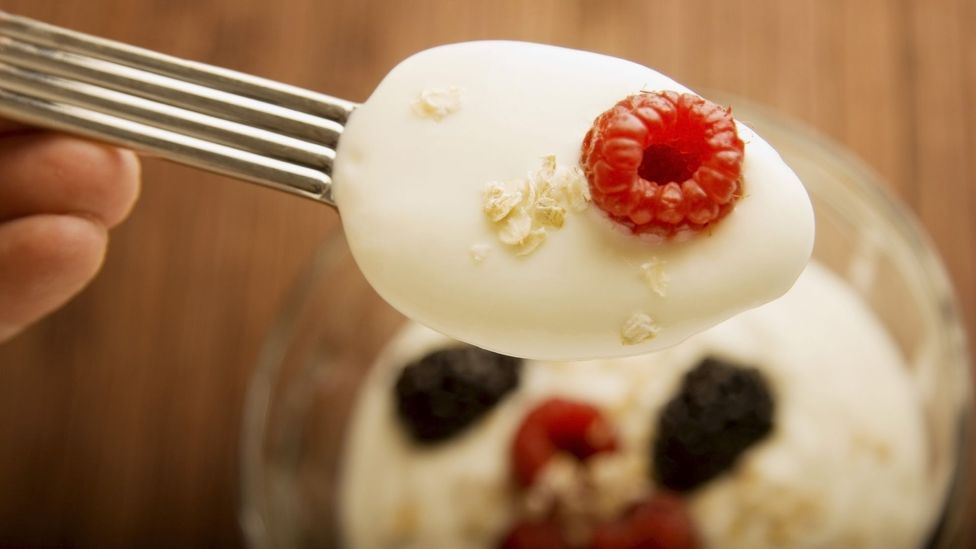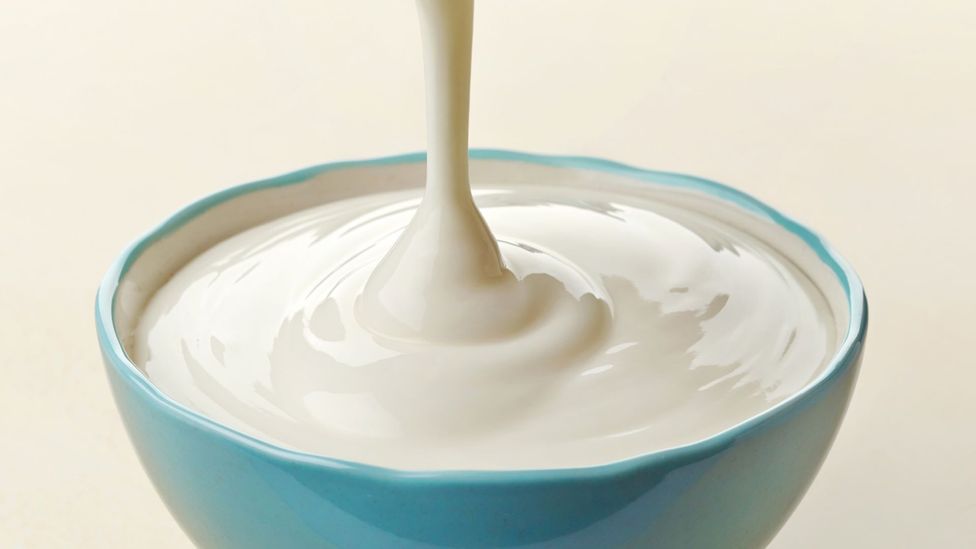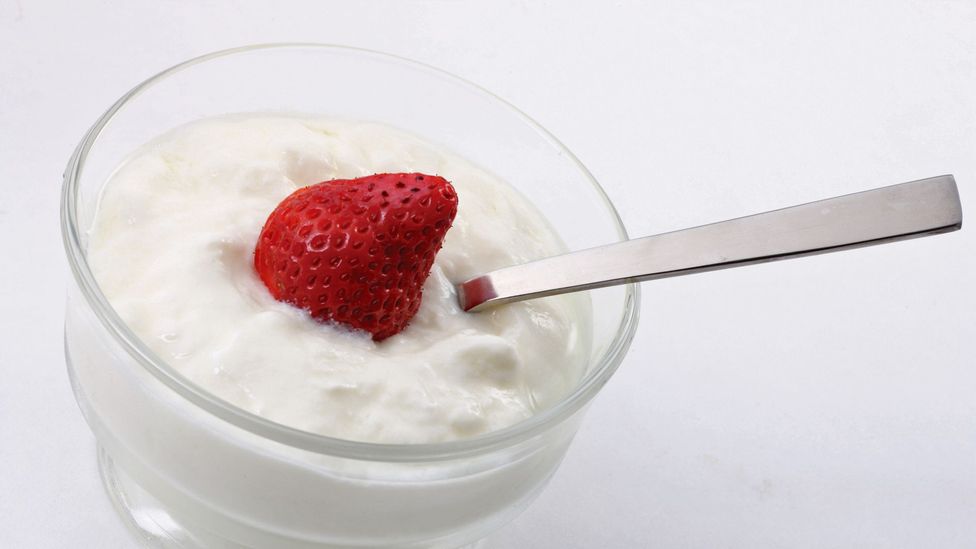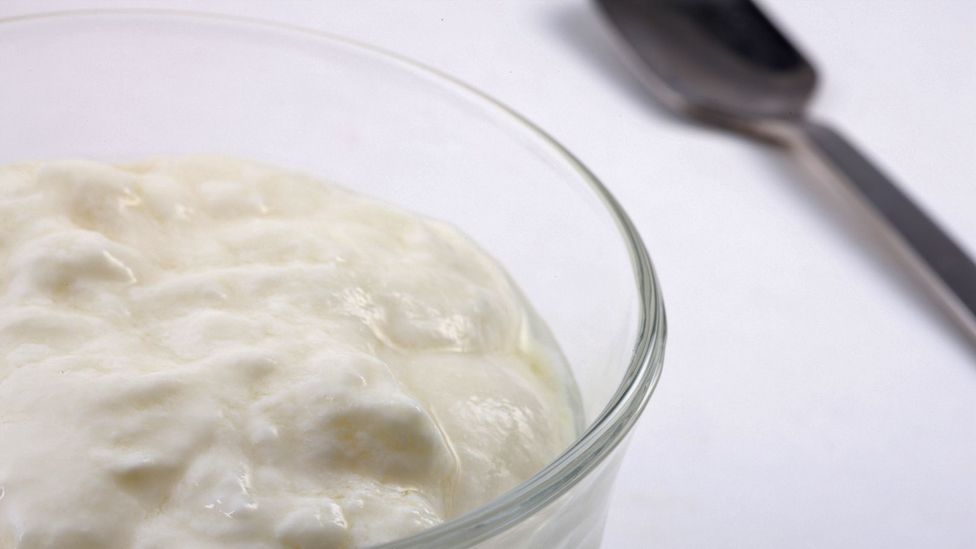Can You Make Yogurt With Evaporated Milk
The secret to making great-tasting yoghurt
(Image credit:
Getty Images
)

Heating and cooling curdled milk creates an amazing chemical process that leads to i of our nearly soothing foodstuffs - yoghurt.

Adding rut unfolds the milk proteins, helping give yoghurt its creamy texture (Credit: Getty Images)
Yoghurt making is a controlled curdling procedure. Basically, you're forcing the milk to go off in a very specific style. To lay the groundwork for the correct final texture, commercial manufacturers agitate the milk in a device a lot like a washing auto. This changes the microscopic structure of the milk by breaking up its big fat globules into lots of little ones. Then milk proteins class skins around each glob. This means that when the milk startles to curdle, and the proteins start to stick to each other, there will be a more even distribution of fat throughout the yoghurt.
Then the temperature is turned upwardly. The heat helps kill off any stray leaner that are in the milk, and information technology likewise starts the chore of unfolding the proteins so that they tin grade the molecular mesh that lies at the heart of yoghurt.
The temperature the milk should be heated to – and for how long – depends on the desired flavour. In commercial operations the milk oftentimes stands at 85C for 30 minutes or between 90C and 95C for five minutes. The makers of a kitchen appliance for making yoghurt at home annotation, "Yoghurt made from milk kept below 170F (76C) is thinner and tastes fresh, a little fruity and more tart, while yoghurt fabricated from milk held at 195F (90C) for 10 minutes is noticeably thicker and tastes less tart and somewhat creamy/nutty/eggy."
Once the heated milk has been brought down to human torso temperature – around 37C – it'south ready for what many think of as the defining process in yoghurt: fermentation. At this temperature the two almost common yoghurt-making bacteria, Lactobacillus delbrueckii subsp.bulgaricus and Streptococcus thermophilus, will thrive. As they grow, they have lactose, a milk sugar, and ferment it into lactic acid. The acid builds upwardly and the pH of the milk drops.
The milk proteins notice the change. Upwards to this bespeak, they have been packed together, either around fat globules or in their own minor clusters that are stabilised by a table salt called calcium phosphate. Merely this table salt dissolves at low pH. As a effect, the clusters get-go to loosen. Downwardly, downwardly, goes the pH, and the proteins in the clusters are freed to brainstorm linking to each other, forming a mesh. They trap water and fat globules in the chains of clusters and proteins. Milk has become yoghurt.

Mass-produced yoghurts follow centuries of local know-how from yoghurt-making cultures (Credit: Getty Images)
When the fermentation process is arrested past cooling the yoghurt downward, the outcome is a gel. In strained yoghurt, like Greek yoghurt, there is an extra step that involves breaking the gel by stirring and so separating out water, sugar, and proteins in the grade of whey. That creates a texture that's more than creamy than gel-similar – but fifty-fifty without straining, everything from the heating of the yoghurt to the protein content of the milk can affect the final texture.
And you'd better believe that all of yoghurt's potential textures have been studied by nutrient scientists and food companies. The number of devices used for testing these qualities is slightly humorous, though you lot tin run into why it would be convenient to have objective measurements.
There's the consistometer, a gadget with a reservoir at the superlative of a ramp that lets you essentially race yoghurts, timing how long information technology takes them to ooze a given distance. Then there's the viscometers, some of which resemble tiny standing mixers, and the penetrometer, a device that involves simply dropping an object on the yoghurt from a pre-defined superlative and seeing how far it goes in. (All of these, of class, can be used for nearly anything whose consistency you'd similar to measure.)

Cooling the yoghurt downward turns the cooked milk into a gel, farther calculation to the texture (Credit: Getty Images)
Amateur yoghurt-makers with microscopes may be pleased to acquire they are in good company. Commercial manufacturers also use microscopes to appraise the construction of their yoghurt's gel, admitting ofttimes ones of college magnification. Using fluorescent tags, they tin see the clusters of proteins, the bacteria caught in the mesh, the fat globules, and all the other pieces assembled in that delicate chemical dance that make yoghurt what information technology is.
Follow united states of america on Facebook , Twitter , Google+ and LinkedIn
Source: https://www.bbc.com/future/article/20150817-the-secret-to-making-great-tasting-yoghurt
Posted by: montgomerypecter.blogspot.com

0 Response to "Can You Make Yogurt With Evaporated Milk"
Post a Comment